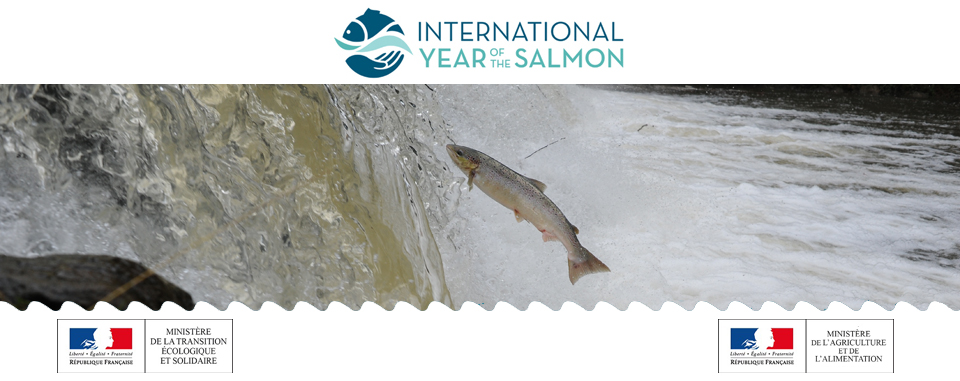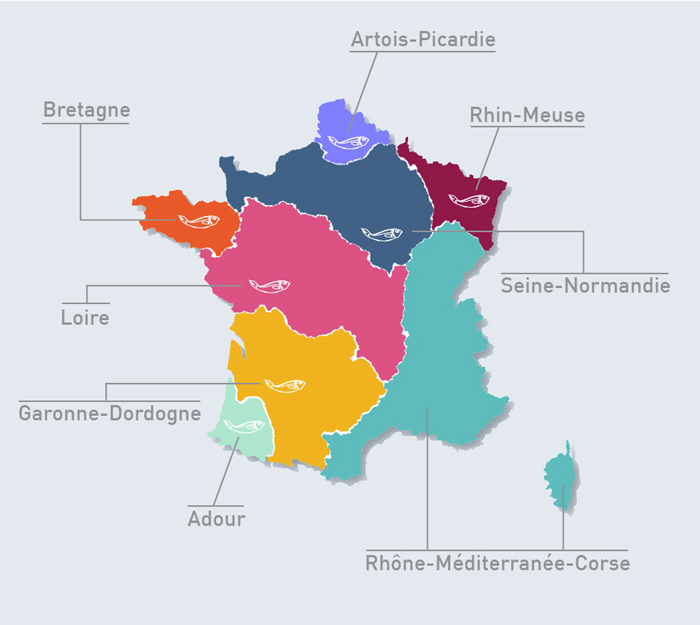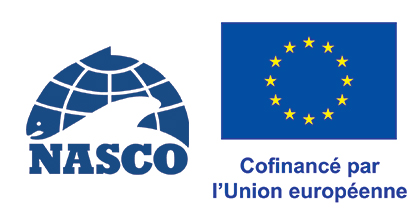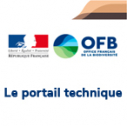International Year of the Salmon - 2019 (projects and activities continuing into 2022)

Mobilise stakeholders and increase action
By taking part in the International Year of the Salmon, France is demonstrating its desire to collaborate with others and follow the recommendations of the North Atlantic Salmon Conservation Organization (NASCO) regarding the management of Atlantic salmon.
In particular, France is declaring its commitment to work on behalf of this extraordinary species through collective work to draft the objectives of the upcoming 2019-2024 action plan, which will be jointly steered by the ministries of the environment and fisheries, with technical support from the French Biodiversity Agency (FBA).
These two projects require the mobilisation of all the partners involved in managing aquatic environments to implement multiple actions to support the conservation of salmon, and amphihaline species in general.
Actions such as restoring watercourse continuity and physical characteristics or implementing effective fishery management policies are important steps towards rebuilding salmon populations.
This page gives direct access to information on Atlantic salmon management in France.
France’s speech at the International Year of the Salmon launch
Christophe Aubel - Former Managing Director of FBA
Maps of French management committees for migratory fish (COGEPOMI)

Migratory fish management for major catchment areas is supervised locally by management committees for migratory fish (COGEPOMI) which include all parties involved.
They implement management plans for migratory fish (PLAGEPOMI), which define 5-year measures to support reproduction, development, conservation and movement of species, plans to support stocks and conditions for fishing in their respective catchment areas.
These plans include local applications of the national plan for salmon in line with territorial characteristics and the human and technical resources available.
The revision of PLAGEPOMI and French strategic water management plans (SDAGEs) is synchronised, allowing the SDAGEs to draw on the work carried out for development of the PLAGEPOMI, and so comply with guideline no.13 of the French national strategy for migratory amphihaline fish (STRANAPOMI). Protection measures are also set out in Natura 2000 site documents of objectives.
The year 2021 is devoted to write new PlaGePoMi for most of the basins river. They take into account the NAP and NAP has taken into account the balance sheets of the former PlaGePoMi.
A Wrap-Up symposium will be organized from October 4 to 6, 2022 in Vancouver (Canada). This symposium will highlight the knowledge gained over the IYS years throughout the North Pacific and North Atlantic. A Roadmap to 2030 can be written.
> For more information: https://yearofthesalmon.org/symposium_participation/
Online resources
1. FBA and its partners are carrying out several actions to better understand and preserve Atlantic Salmon (movies)
These movies were made with funding from the European Union as part of the International Year of the Salmon

2. Monitoring French salmon populations
The French national data portal for migratory fish (PONAPOMI) was set up by the French Biodiversity Agency (FBA) in 2018.
3. Salmon and climate change
This report gives an overview of current knowledge on climate change and its impacts on the hydrology of watercourses on the French mainland and fish biodiversity.
The state of the art report presents various projection tools and their scope of application, providing quantitative responses on the scale of changes expected.
A chapter is also devoted to adaptation measures which could be implemented in line with current regulations to limit the vulnerability of fish and freshwater ecosystems with immediate and long-term effect.
4. The national plan for diadromous fishes (PNMA)
The national action plan (NAP) for migratory fish species in France would provide a practical document which sets out how migratory fish (especially Atlantic salmon) will be conserved and restored throughout France. The development of this NAP during the International Year of the Salmon would be a chance to make salmon an emblematic species, and the flagship species of all the French anadromous species. This NAP will include SMART objectives and clear guidance to fish managers.
5. French research on salmon
6. Partner associations working on salmon in France
> LOGRAMI : http://www.logrami.fr/sensibilisation/poissons-migrateurs/saumon/
The Loire is the last European river to host a population of large salmon species capable of migrating up to 10,000 km, including nearly 1000 km in freshwater. Upstream counts for salmon in the catchment area are between 500 and 1000 individuals per year.
> Saumon-Rhin : http://www.saumon-rhin.com/decouverte/especes-migratrices/le-saumon/
Will France fulfil its commitment to see salmon as far upstream as Basel in 2020, and under what conditions? For the moment, the number of large migratory species reaching Alsace’s hydroelectric dams is on the rise.
> Bretagne Grands Migrateurs : http://www.observatoire-poissons-migrateurs-bretagne.fr/connaitre-le-saumon-atlantique/aire-de-repartition-et-evolution
There are two genetically different groups of Atlantic salmon in the Bretagne region. The Armorica group grows and reproduces in the rivers to the west of the Couesnon river. The Vilaine river is the southern limit of this group’s colonies. The Couesnon river salmon are part of the Bas-normande group.
> MIGADO : http://www.migado.fr/saumon/
The return of around 15,000 salmon recorded at counting stations between 1993 and 2017 offer a promising outlook for the future of the species in the Garonne and Dordogne river areas. The catchment area’s population primarily consists of individuals who have spent several winters at sea, i.e. they have spent at least 2 years in the Atlantic Ocean before returning to the catchment area to reproduce.
> MIGRADOUR : http://www.migradour.com/fiches/especes/saumon.html
“Saumon de l’Adour” is a salmon that swims up from the mouth of the Adour rivers to the Pyrenees streams around Pau and Oloron.
> Normandie Grands Migrateurs : http://normandiegrandsmigrateurs.fr/les-poissons-migrateurs-de-normandie/saumon-atlantique/presentation-saumon-atlantique/
The many river conservation and restoration programmes have been offering a better outlook for several years, and trends observed at counting stations for migrating adult salmon and abundance indices for juveniles produced using electrofishing are generally on the rise for most watercourses studied in the Manche, Calvados and Orne départements.
> Tableau de bord Migrateurs Charente Seudre https://www.migrateurs-charenteseudre.fr/tableaux-de-bord/saumon-atlantique/
The situation for salmon in the Charente river catchment area is critical. Salmon have now disappeared from the Boutonne river, and salmon swimming up the Charente are now increasingly sporadic.



